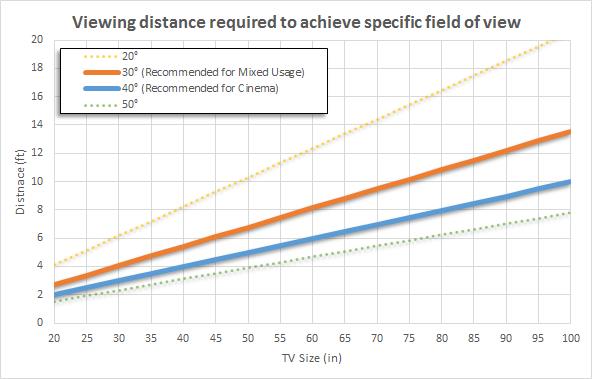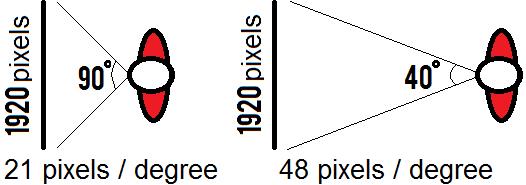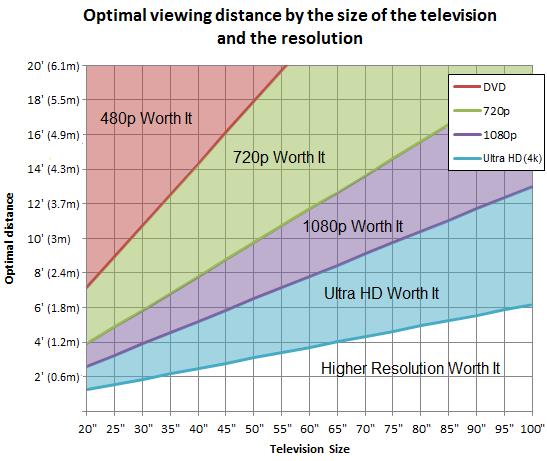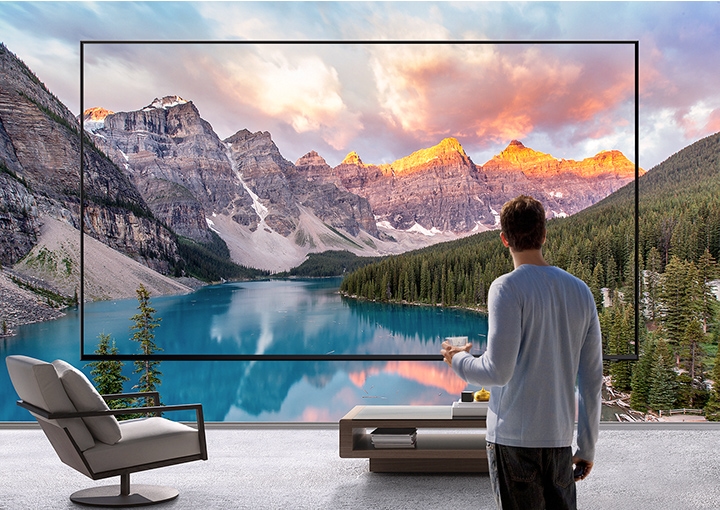What Size TV or Screen ?
Whilst you may be thinking of buying a new TV or considering an upgrade to a projector screen, you may find the following information useful.
One of the most common questions we get asked is:
‘what size TV should I buy for my living room?’
Besides the subjective assessment of judging how the size of the TV will blend into the room/furniture/aesthetics, there is a more scientific way of answering this question. It comes down to the ‘field of view’ and the resolution of the content you are watching!
TV Size to Distance Calculator and the Science behind it:
Bigger and closer is usually better when it comes to choosing the perfect television for your room. Not only is it the biggest factor affecting the price of a television, but it also has a huge impact on the perceived picture quality.
Things to consider when working out what size TV or projector screen to buy:
1.Field of View
The human visual system has an angle of view of about 135 degrees horizontally. The size of the TV or screen and the distance we sit from it, determine our Field of View. This impacts how we perceive and immerse ourselves in the image displayed.
Since most TV resolutions found today are HD or 4K, It takes a very big TV watched from very close distance to see imperfections related to the resolution. Because of this, one can appreciate their TVs detail from much closer, for a more immersive experience. Just like a movie theatre, the more a TV fills your view, the more captivating the content will become.
That doesn’t mean you should be sitting a foot away from your TV. Not everybody prefers having the largest screen possible. Although we see up to 135 degrees horizontally, and while it makes some sense to get as large a TV you can for movies, content isn’t produced to be viewed while filling the entire field of vision. This becomes very apparent if you try to watch sports from up close while fixating a single part of the screen, as it gets quite nauseating.
The Guidelines from the Society of Motion Picture & Television Engineers recommends sitting at a distance where the screen fills up about 30° of your field of vision as a minimum for a good experience.
However in home or commercial theatres, it is recommended that the projector screen fills 40 to 45 ° of view.

The graph below shows relationship between TV size and distance for achieving this optimum 30– 40° of view.

So, for example, according to the graph it is recommended that you would place your sofa between 5.5 to 7.5 feet away from a 55” Screen.
This generally provides good guidance, but people that use their TVs mostly for watching movies may benefit from sitting a bit closer to get a more theatre-like experience. The SMPTE “reference” position for movie theatres and the THX recommendation is about 40°. The minimum angle of 30° vision works well for most TV usages though and sitting at a distance where the screen fills 30° of your horizontal field of view should be comfortable for most people. A 40° field is better for cinema like usage. A table showing distances is given below:
Screen Size…….Distance for 30°……..Distance for 40°
30″…………………4.1′ (1.24 m)……………3′ (0.92 m)
40″…………………5.5′ (1.66 m)……………4′ (1.22 m)
50″…………………6.8′ (2.06 m)……………5′ (1.53 m)
55″…………………7.5′ (2.28 m)……………5.5′ (1.68 m)
60″…………………8.2′ (2.48 m)……………6′ (1.83 m)
65″…………………8.9′ (2.69 m)……………6.5′ (1.98 m)
70″…………………9.5′ (2.9 m)……………..7′ (2.13 m)
75″…………………10.2′ (3.1 m)……………7.5′ (2.29 m)
85″…………………11.6′ (3.52 m)…………..8.5′ (2.59 m)
2. Angular resolution
The closer you are to a screen, the lower your perceived pixel density will be.
Higher field of view was first made possible with Full HD resolutions, but 4k enhances that ability even more. Sitting very close to a 1080p TV will look low resolution, even if it is playing a high quality 1080p HD movie. By increasing your distance from the TV, the density of the details will increase, producing a better image. This is the angular resolution: the number of pixels per angle. The farther away, the higher the angular resolution will be.
Since 4k TVs and projectors have such a large density of pixels, it is much more difficult for this issue to arise. You need to be quite close to a fairly large TV for it to be noticeably annoying.

The limit to which you can increase the angular resolution by stepping back depends on your visual acuity (ie how good is your eyesight). At some point, your eyes are not good enough to distinguish all the details. Studies show that someone with 20/20 vision can distinguish something 1/60 of a degree apart. This means 60 pixels per degree or 32 degrees for a 1080p television. 4k UHD TVs double that to 64 degrees. Keep in mind that you can see a single pixel from further away (depending on its contrast with the rest of the picture).
For 4k, this distance is often too close for most people. This is because 1080p was designed around the field of view logic above. It is the cutting point at which both the optimal field of view and 60 pixels per degree meet. For lower resolutions, it meant sitting a bit further than preferable to not notice the pixels, 4k resolutions and higher give you a lot more freedom. Because of this, visual acuity isn’t really the best way to find the right distance anymore, and it should instead be used as a way to figure out the closest point you can sit to a TV without hitting its resolution limitation.

The chart above gives more details for optimal viewing distance based on content you are watching. It shows, for example, that a 4k upgrade is not worth it if you are sitting more than 6′ away and only have a 50″ TV. Your eyes won’t be able to tell the difference. Ultra HD resolution actually only really makes sense if you want a really big screen and plan on sitting closer to it.
TV Size…….Optimal Distance (HD)……….Optimal Distance (UHD 4k)
40″………….5.1′ (1.56 m)……………………….2.3′ (0.71 m)
50″………….6.3′ (1.93 m)……………………….2.9′ (0.89 m)
55″………….7′ (2.14 m)………………………….3.2′ (0.98 m)
60″………….7.6′ (2.32 m)……………………….3.8′ (1.16 m)
65″………….8.2′ (2.5 m)…………………………4.1′ (1.25 m)
70″………….8.9′ (2.72 m)……………………….4.4′ (1.35 m)
How do you interpret the chart?
There are a few ways to read the chart. For example, let’s say that you have a 50″ television. Start at the bottom of the chart at 50″. Up to 3′, you are below the blue line. This means you can see the pixels of an Ultra HD resolution. If you go back a bit (up in the chart), between 3′ and 7′, an Ultra HD resolution does not matter anymore because you cannot see the extra pixels anyway. However, you are still too close for a 1080p resolution (it will not appear perfect). Above 7′, the perceived quality will start to decrease for 1080p because your eye will not see all the details. You would notice the difference though, it if was 720p. For more than 10′, it does not matter if it is a 720p or 1080p HDTV, your eyes are not good enough to see the difference. You will still see the difference for a standard resolution video, though, up to a distance of 18′. To summarise, you can see the pixels if you are below the line, but not when you are above.
To use your TV’s resolution to its maximum, you want to be exactly on the line for your TV dimensions and media resolution.
3 Compression Artifacts
This takes into account perfect resolution, which is never the case in real life. Even if you are watching a HD channel presented in high resolution, there will be some artifacts due to the compression algorithm. Artifacts can appear in multiple forms like noise, blurs or a pixelated image (see the picture to the right). You will be able to see artifacts from farther away, so consider the above numbers as being for perfect 1080p media. The numbers show the minimum distance at which you start losing the advantage of the resolution. However, as 4k TVs are the most common, we recommend using our FOV chart as angular resolution is almost a non-issue with UHD content.
4 Budget
You are probably now thinking something along the lines of “My couch is 10′ away from my TV, which according to the chart means I need a 75 inch TV. This is insane!”. Yes, if you want to take advantage of the full capacity of higher resolutions, this is the ideal size. This brings us to another factor for most people: the budget.
Historically, the price of a TV has been exponential to its size, and large TVs were for very large budgets! However, in recent times TV prices have dropped dramatically at the larger size ranges.
However for a true immersive and cinematic experience there is just no substitute for having a projector and screen if you have room to go over 75" in size.
Projectors and screens are very affordable nowadays and of excellent quality, resolution and brightness. Have a look at our store for our selection of screens and projectors that we supply and install.
Conclusion
We recommend an angle of vision of 30 degrees for a mixed usage TV. In general, we also recommend getting a 4k TV since 1080p choices will become less common over time and lack modern features such as HDR. We also recommend a viewing angle of at least 40 degrees for cinematic use (which will usually mean a projection system). We can provide angle measurements and screen size measurements/design and advice during sales and surveys. To roughly find out what size screen you should buy, you can divide your TV viewing distance (in inches) by 1.6 (or use our TV size calculator above) to equate to a 30 degree angle.

